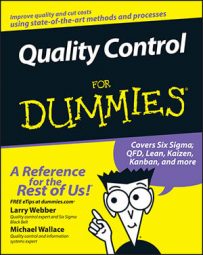The Theory of Constraints (TOC) is a comprehensive technique for identifying and managing an organization's constraints for obtaining maximum output from a process (or throughput).
The TOC says that a traditional approach of optimizing individual processes only occasionally helps throughput. For years, companies have spent large amounts of money to improve their processes. They have eliminated waste, shrunk inventories, and so on, but these improvements haven't delivered a corresponding quantity of savings. The disconnect occurs because the companies focused on speeding up individual processes to become more efficient, often with no overall improvement in throughput.
Why optimize a process to produce a product or deliver a service faster or more efficiently if its output will just pile up further down the chain next to a constraint? The key to improving throughput is to manage the constraint that prevents maximum process throughput.
Much of a company's internal friction is between departments and processes. As measurements and improvements are applied to one process at a time — often confined to the same department — no one is looking at the "touch points" where products and responsibility move into someone else's hands. The TOC has a big-picture approach to quality that encompasses problems occurring between processes.
The TOC aims to identify and resolve internal conflicts — often between policies. You need to make sure that the result of resolved conflicts is a win-win situation for all involved parties; if you use the TOC to bludgeon processes and managers, you'll see it quickly fade away.
Concentrate on throughput upfront
Most companies measure their production or service processes individually. They look at how efficiently orders are received or how promptly bills are paid. They encourage managers who oversee their processes to optimize them through improvement tools, outside advisors, and even cost reductions, and give rewards for jobs well done. However, each isolated improvement may have a negative effect on another process. Many companies don't rate improvement by how much they improve output of the facility to the customer; they rate only on how much faster one individual process works, and they emphasize only the cost-cutting benefits of improving quality.
The TOC's global view perceives improving the speed of individual processes as a waste of time and money. If the accounts-payable process isn't constraining the speed of throughput, why spend time and money to improve it? Although cutting costs provides an immediate bottom-line impact, it can go only so far in quality improvement. After all, costs can drop only to zero.
Lean processes, Six Sigma, and the Theory of Constraints all have different ideas of the nature of waste:
- Lean's emphasis on process flow stipulates that waste is anything that doesn't add value.
- Six Sigma fights waste in the form of variation in a process or its inputs.
- The TOC defines waste as a constraint on a system's throughput.
The TOC focuses first on increasing income, as its potential is unlimited. (Of course, income has an upper limit, but how many companies have fully exploited and dominated their own markets?) Cutting costs is a secondary priority. The TOC uses throughput, inventory, and operating expense as measures to guide company decisions:
- Throughput is the rate at which the company's processes create cash for the company through sales of its products or services.
- Inventory is an investment in tooling, labor, materials, and any other items needed to create goods for sale.
- Operating expense is the cash spent to convert inventory into throughput.
The biggest gains from the TOC technique come from increasing throughput. After that, companies should pay attention first to inventory and last to operating expense. This hierarchy conflicts with the traditional quality concerns of first cutting inventory and labor to improve profits.
Don't overfeed the process!
If you find that a constraint limits the throughput of an important process in your organization, it doesn't make sense for you to improve upstream processes to run faster. Doing so just creates piles of work-in-process material at the bottleneck. The TOC refers to this problem as overfeeding the process.
Implementation of the TOC (combined with Lean processes) reduces the rate of upstream processes to keep the constraint supplied without piling up excess work. As you consolidate and then shrink the work-in-process materials, workers can see that the amount of inventory on hand isn't related to the facility's output.
People are funny creatures. If they have jobs like printing paychecks, counting nails, or whatever, and they can work so fast as to pile up work ahead of a constraint, they quickly learn to slow down and soak up the time. The maxim that "work expands to fill the time allotted" is true. What this means for your organization is that a constraint may not always be obvious if the behavior of other links in the operating chain disguises it. Look at the entire process from end to end to identify areas that may be walking slowly — adding non-value-added steps — to soak up the excess time. This review also brings out any "near constraints" that you can address.

